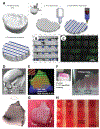Micro- and Macrobioprinting: Current Trends in Tissue Modeling and Organ Fabrication
- PMID: 30397639
- PMCID: PMC6214196
- DOI: 10.1002/smtd.201700318
Micro- and Macrobioprinting: Current Trends in Tissue Modeling and Organ Fabrication
Abstract
The recapitulation of human anatomy and physiology is critical for organ regeneration. Due to this fundamental requirement, bioprinting holds great promise in tissue engineering and regenerative medicine due to the possibility of fabricating complex scaffolds that host cells and biochemical cues in a physiologically relevant fashion. The ever-growing research in this field has been proceeding along two different, yet complementary, routes: on the one hand, the development of bioprinting to fabricate large tissue surrogates for transplantation purposes in vivo (macrobioprinting), and on the other the spread of bioprinting-based miniaturized systems to model the tissue microenvironment in vitro (microbioprinting). The latest advances in both macro- and microbioprinting are reviewed, emphasizing their impact on specific areas of tissue engineering. Additionally, a critical comparison of macro- versus microbioprinting is presented together with advantages and limitations of each approach. Ultimately, findings obtained both at the macro-and microscale are expected to provide a deeper insight in tissue biology and offer clinically relevant solutions for organ regeneration.
Keywords: bioprinting; complex tissues; organ-on-a-chip; regenerative medicine; tissue engineering.
Conflict of interest statement
Conflict of Interest The authors declare no conflict of interest.
Figures





Similar articles
-
[Biofabrication: new approaches for tissue regeneration].Handchir Mikrochir Plast Chir. 2018 Apr;50(2):93-100. doi: 10.1055/s-0043-124674. Epub 2018 Jan 29. Handchir Mikrochir Plast Chir. 2018. PMID: 29378379 Review. German.
-
Advances in Regenerative Medicine and Biomaterials.Methods Mol Biol. 2023;2575:127-152. doi: 10.1007/978-1-0716-2716-7_7. Methods Mol Biol. 2023. PMID: 36301474
-
Bioprinting for vascular and vascularized tissue biofabrication.Acta Biomater. 2017 Mar 15;51:1-20. doi: 10.1016/j.actbio.2017.01.035. Epub 2017 Jan 11. Acta Biomater. 2017. PMID: 28087487 Review.
-
3D Bioprinting and Its Application to Military Medicine.Mil Med. 2020 Sep 18;185(9-10):e1510-e1519. doi: 10.1093/milmed/usaa121. Mil Med. 2020. PMID: 32514549
-
3D bioprinting of tissues and organs for regenerative medicine.Adv Drug Deliv Rev. 2018 Jul;132:296-332. doi: 10.1016/j.addr.2018.07.004. Epub 2018 Jul 7. Adv Drug Deliv Rev. 2018. PMID: 29990578 Review.
Cited by
-
Fully Three-Dimensional Bioprinted Skin Equivalent Constructs with Validated Morphology and Barrier Function.Tissue Eng Part C Methods. 2019 Jun;25(6):334-343. doi: 10.1089/ten.TEC.2018.0318. Tissue Eng Part C Methods. 2019. PMID: 31007132 Free PMC article.
-
Addressing present pitfalls in 3D printing for tissue engineering to enhance future potential.APL Bioeng. 2020 Feb 10;4(1):010901. doi: 10.1063/1.5127860. eCollection 2020 Mar. APL Bioeng. 2020. PMID: 32072121 Free PMC article.
-
Metal Nanoparticles in Laser Bioprinting.Nanomaterials (Basel). 2021 Sep 30;11(10):2584. doi: 10.3390/nano11102584. Nanomaterials (Basel). 2021. PMID: 34685024 Free PMC article.
-
Sustained released of bioactive mesenchymal stromal cell-derived extracellular vesicles from 3D-printed gelatin methacrylate hydrogels.J Biomed Mater Res A. 2022 Jun;110(6):1190-1198. doi: 10.1002/jbm.a.37362. Epub 2022 Jan 25. J Biomed Mater Res A. 2022. PMID: 35080115 Free PMC article.
-
Preclinical Testing of 3D Printed, Cell Loaded Hydrogel Based Corneal Substitutes on Rabbit Model.Macromol Biosci. 2025 Jul;25(7):e2400595. doi: 10.1002/mabi.202400595. Epub 2025 Mar 27. Macromol Biosci. 2025. PMID: 40145466 Free PMC article.
References
Grants and funding
LinkOut - more resources
Full Text Sources

